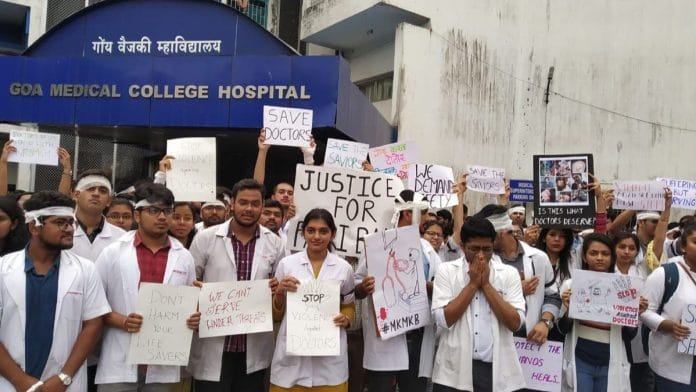Thank you dear subscribers, we are overwhelmed with your response.
Your Turn is a unique section from ThePrint featuring points of view from its subscribers. If you are a subscriber, have a point of view, please send it to us. If not, do subscribe here: https://theprint.in/subscribe/
WHO defines an attack on health care as “any act of verbal or physical violence or obstruction or threat of violence that interferes with the availability, access and delivery of curative and/or preventive health services during emergencies. Types of attacks vary across contexts and can range from violence with heavy weapons to psychosocial threats and intimidation”.
According to the Indian Medical Association’s (IMA) Kerala president, Sulphi Noohu, “At least five cases of attacks on doctors are reported every month in Kerala and more than 200 such attacks, including intimidation and threats, have been reported in the past three years,”, The organization is demanding comprehensive legislation to fight violence against health care professionals. According to a study by the IMA, over 75% of doctors have faced violence of some kind in the workplace. In most cases, the patient’s relatives were actively involved.
In 2019, there was a mass resignation of doctors in West Bengal after a mob attacked a junior doctor. The attack was triggered by the death of a patient, with the family alleging medical negligence.
Looking beyond individual incidents, experts say the violence needs to be understood within the context of India’s poor quality and inaccessibility of public health system. The problems including improper management due to limited resources and staff, high health care costs, and extended stays in private hospitals, as factors leading to potentially violent situations.
Government figures show there are 3.4 million registered nurses and 1.3 million allied and health care professionals, including doctors, in the country. This is far too few for India, which has recently overtaken China to become the most populous country in the world. According to the Indian Journal of Public Health, India will need at least 2 million doctors by 2030.
But that does not mean healthcare workers should be attacked in any circumstance.
Indian health care workers now suffer more nonfatal injuries from workplace violence than workers in any other profession, probably including law enforcement. Health care workers don’t even anticipate violence when they decide to be a nurse or a doctor. But as far as actual violence goes, statistically, health care is four or five times more dangerous, especially in government hospitals, than in any other profession.
Majority of Indian states and union territories (UTs) have so far adopted the Medicare Service Persons and Medicare Service Institutions (Prevention of violence and damage or loss to property) Act that punishes violent perpetrators. States and UTs have modified the same act and, confusingly, several variations exist, with some more stringent than others.
Some states and five UTs in India still have no law to tackle violence against healthcare workers. Even where legislation is in place, it’s been reported that few cases under this act reaches the courts after charges were filed. Despite widespread recognition of the problem and several calls from medical associations, there is still no national legislation in place.
To minimise the risk to workers hospitals too need to act. Hospital administrations should adopt standard protocols for violent incidents. Educating through infographics shunning violence, installing alarm systems, improving security could be some of the precautions.
Hospitals need to also establish grievance cells to lodge disputes. Zero tolerance towards violence, defining unacceptable behaviour and the consequences of violation, also need to be promulgated.
The media also has a big part in shaping public opinion about healthcare workers and in offering a balanced portrayal of their work, rather than a sensationalised one.. The media has a responsibility to advocate for the lives of healthcare workers and broadcast awareness about legal penalties.
Citizens too have a moral responsibility to condemn any kind of violence against healthcare workers. It is appalling to note that prominent citizens rarely condemn such violence in public. Citizen steering activism, advocacy, and support for healthcare workers will go a long away in reducing violence. Non-governmental organisations and civil societies can raise awareness, build bridges between communities and healthcare workers, and mobilise people to call on the government to take legal action and increase healthcare funding.
Finally, at the individual level, healthcare workers should undergo training in safety and identification of early markers of violence to help them manage or prevent interactions that turn aggressive. Violence against healthcare workers needs to be acknowledged as a social problem that requires action at multiple levels. Continued violence can lead to large scale unrest among healthcare workers that will, in turn, disrupt the health system and, ultimately, harm patient care.
Col KL Viswanathan
(The author is an Indian Army veteran and a contemporary affairs commentator. The views are personal.)
These pieces are being published as they have been received – they have not been edited/fact-checked by ThePrint.


